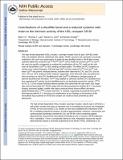Contributions of a disulfide bond and a reduced cysteine side chain to the intrinsic activity of the HDL receptor SR-BI
Author(s)
Yu, Miao; Lau, Thomas Y.; Krieger, Monty; Carr, Steven A
DownloadKrieger_Contributions of.pdf (2.835Mb)
PUBLISHER_POLICY
Publisher Policy
Article is made available in accordance with the publisher's policy and may be subject to US copyright law. Please refer to the publisher's site for terms of use.
Terms of use
Metadata
Show full item recordAbstract
The high density lipoprotein (HDL) receptor, scavenger receptor class B, type I (SR-BI), binds HDL and mediates selective cholesteryl ester uptake. SR-BI's structure and mechanism are poorly understood. We used mass spectrometry to assign the two disulfide bonds in SR-BI that connect cysteines within the conserved Cys[superscript 321]-Pro[superscript 322]-Cys[superscript 323] (CPC) motif and connect Cys[superscript 280] to Cys[superscript 334]. We used site-specific mutagenesis to evaluate the contributions of the CPC motif and the side chain of extracellular Cys[superscript 384] to HDL binding and lipid uptake. The effects of CPC mutations on activity were context dependent. Full wild-type (WT) activity required Pro[superscript 322] and Cys[superscript 323] only when Cys[superscript 321] was present. Reduced intrinsic activities were observed for CXC and CPX, but not XXC, XPX or XXX mutants (X≠WT residue). Apparently, a free thiol side chain at position 321 that cannot form an intra-CPC disulfide bond with Cys[superscript 323] is deleterious, perhaps because of aberrant disulfide bond formation. Pro[superscript 322] may stabilize an otherwise strained CPC disulfide bond, thus supporting WT activity, but this disulfide bond is not absolutely required for activity. C[superscript 384]X (X=S,T,L,Y,G,A) mutants exhibited altered activities that varied with the side chain's size: larger side chains phenocopied WT SR-BI treated with its thiosemicarbazone inhibitor BLT-1 (increased binding, decreased uptake); smaller side chains produced almost inverse effects (increased uptake:binding ratio). C[superscript 384]X mutants were BLT-1 resistant, supporting the proposal that Cys[superscript 384]'s thiol interacts with BLT-1. We discuss the implications of our findings on the functions of the extracellular loop cysteines in SR-BI and compare our results to those presented by other laboratories.
Date issued
2012-12Department
Massachusetts Institute of Technology. Department of Biology; Koch Institute for Integrative Cancer Research at MITJournal
Biochemistry
Publisher
American Chemical Society (ACS)
Citation
Yu, Miao et al. “Contributions of a Disulfide Bond and a Reduced Cysteine Side Chain to the Intrinsic Activity of the High-Density Lipoprotein Receptor SR-BI.” Biochemistry 51.50 (2012): 10044–10055.
Version: Author's final manuscript
ISSN
0006-2960
1520-4995